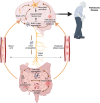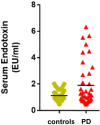The Endotoxin Hypothesis of Parkinson's Disease
- PMID: 37157885
- PMCID: PMC10947365
- DOI: 10.1002/mds.29432
The Endotoxin Hypothesis of Parkinson's Disease
Abstract
The endotoxin hypothesis of Parkinson's disease (PD) is the idea that lipopolysaccharide (LPS) endotoxins contribute to the pathogenesis of this disorder. LPS endotoxins are found in, and released from, the outer membrane of Gram-negative bacteria, for example in the gut. It is proposed that gut dysfunction in early PD leads to elevated LPS levels in the gut wall and blood, which promotes both α-synuclein aggregation in the enteric neurons and a peripheral inflammatory response. Communication to the brain via circulating LPS and cytokines in the blood and/or the gut-brain axis leads to neuroinflammation and spreading of α-synuclein pathology, exacerbating neurodegeneration in brainstem nuclei and loss of dopaminergic neurons in the substantia nigra, and manifesting in the clinical symptoms of PD. The evidence supporting this hypothesis includes: (1) gut dysfunction, permeability, and bacterial changes occur early in PD, (2) serum levels of LPS are increased in a proportion of PD patients, (3) LPS induces α-synuclein expression, aggregation, and neurotoxicity, (4) LPS causes activation of peripheral monocytes leading to inflammatory cytokine production, and (5) blood LPS causes brain inflammation and specific loss of midbrain dopaminergic neurons, mediated by microglia. If the hypothesis is correct, then treatment options might include: (1) changing the gut microbiome, (2) reducing gut permeability, (3) reducing circulating LPS levels, or (4) blocking the response of immune cells and microglia to LPS. However, the hypothesis has a number of limitations and requires further testing, in particular whether reducing LPS levels can reduce PD incidence, progression, or severity. © 2023 The Authors. Movement Disorders published by Wiley Periodicals LLC on behalf of International Parkinson and Movement Disorder Society.
Keywords: Parkinson's disease; endotoxin; gut; inflammation; lipopolysaccharide; microglia; neurodegeneration; neuroinflammation.
© 2023 The Authors. Movement Disorders published by Wiley Periodicals LLC on behalf of International Parkinson and Movement Disorder Society.
Figures




References
Publication types
MeSH terms
Substances
Grants and funding
LinkOut - more resources
Full Text Sources
Medical

